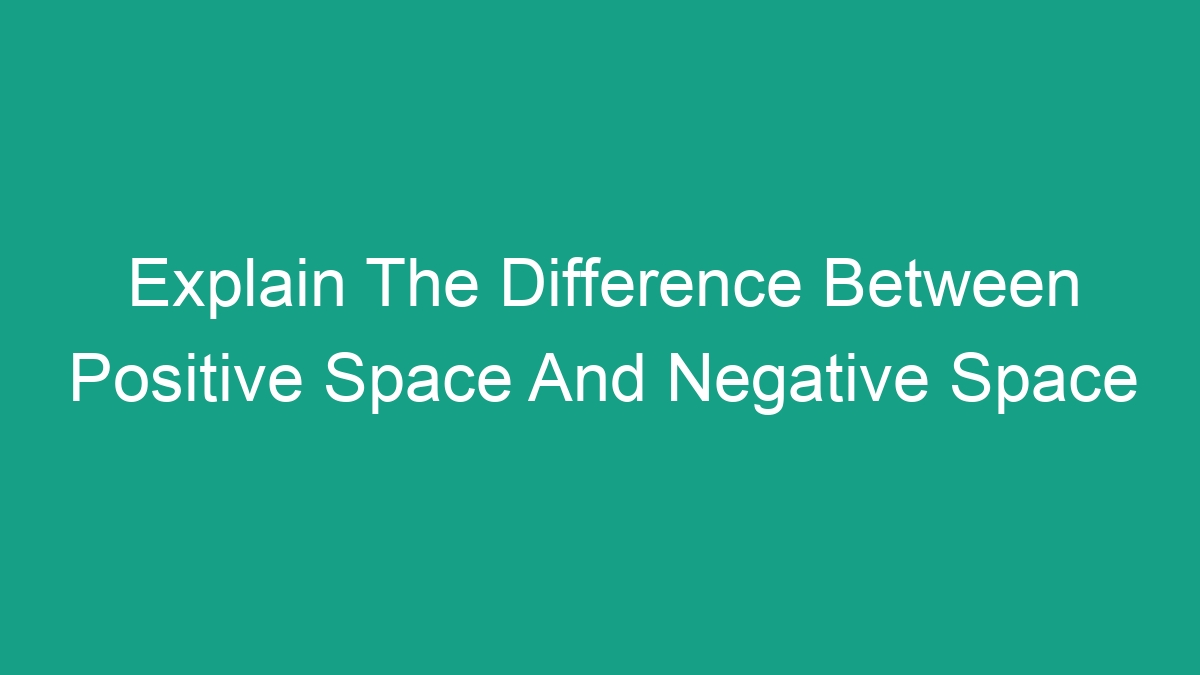
Understanding the Basics
When it comes to the world of art and design, the concepts of positive space and negative space are fundamental to creating visually appealing and balanced compositions. These two elements work hand in hand to create harmony and interest in a work of art, whether it’s a painting, a photograph, or a graphic design. Understanding the difference between positive space and negative space is crucial for artists and designers to effectively convey their message to their audience.
Positive space refers to the main focus of a picture, the object or subject that is the primary point of interest. On the other hand, negative space is the space around and between the subject(s) of an image. It is the background that provides context and allows the positive space to exist. Both positive and negative space are equally important in creating a visually appealing composition.
The Role of Positive Space
In art and design, positive space is often the first thing that grabs the viewer’s attention. It is the primary subject of the composition, the main element that the artist wants the viewer to focus on. Positive space can take many forms, including people, objects, shapes, and forms. It is the area in the artwork that contains the main subject, the primary point of visual interest.
When working with positive space, artists and designers use various techniques to draw attention to the subject. This might include the use of color, contrast, and size to make the positive space stand out. By manipulating these elements, the artist can make the positive space the most visually dominant part of the composition.
The Role of Negative Space
While positive space is the main focus of a composition, negative space plays a crucial role in giving context and balance to the artwork. It is the empty space around the positive space, and it can be just as important in defining the overall composition. Negative space provides breathing room for the positive space and can help draw attention to the main subject by providing contrast.
Negative space can also be used to create a sense of harmony and balance in a composition. The way negative space is utilized can affect the overall mood and visual impact of the artwork. Designers and artists often use negative space to create a sense of calm and tranquility or to enhance the visual impact of the positive space.
Examples of Positive and Negative Space in Art
To better understand the concepts of positive and negative space, it can be helpful to look at some examples in art and design.
One classic example of the use of negative space is the logo for the World Wildlife Fund (WWF). The logo features the image of a panda, which is the positive space, but the space around the panda, which forms the shape of a globe, is the negative space. The clever use of negative space not only draws attention to the panda but also conveys the organization’s message of global conservation.
In photography, negative space is often used to create a sense of drama and impact. For example, a portrait that features a subject against a plain, uncluttered background uses negative space to draw attention to the person’s face and expressions.
Creating Balance and Harmony
One of the key principles in art and design is achieving a sense of balance and harmony in a composition. Positive and negative space work together to achieve this balance by creating visual interest and providing a sense of order to the artwork.
When positive and negative space are used effectively, they can create a sense of movement and flow in the composition. This can lead the viewer’s eye through the artwork, creating a cohesive and harmonious overall impression. Without this careful balance, a composition can feel cluttered and chaotic or empty and lacking in interest.
Practical Applications in Design
In the world of graphic design, understanding the relationship between positive and negative space is crucial for creating effective designs. From logos to websites to advertisements, designers must consider how positive and negative space work together to create visually appealing and impactful designs.
For example, in logo design, negative space can be used to create hidden meanings or symbols within the design. This adds an extra layer of interest to the logo and can help it stand out in the minds of consumers. In web design, negative space is often used to make content more readable and to guide the user’s eye through the page.
Conclusion
In conclusion, the concepts of positive space and negative space are essential elements in the world of art and design. Understanding how these elements work together can help artists and designers create visually appealing and impactful compositions. By carefully considering the relationship between positive and negative space, artists and designers can achieve a sense of balance, harmony, and visual interest in their work.
Whether it’s a painting, a photograph, a logo, or a website, the principles of positive and negative space play a crucial role in creating compelling and effective visual communications. By paying attention to the interplay of positive and negative space, artists and designers can elevate their work to new heights and create compositions that truly resonate with their audience.


